British Bulldog
 Bulldog Stamp
Bulldog Stamp
As the Bulldog was among the first British recognised pure breeds[3] , he is one of our most important. Britain's national dog, his somewhat exaggerated features are a product of the purpose for which this dog was originally created. For although this purpose was outlawed around two centuries ago, the Bulldog's external features combined with his outstanding temperament have become a symbol of British pluck and endurance.
History of the Bulldog
 Bulldogs c 1850
Bulldogs c 1850
The British Bulldog was descended directly from the 'broad mouthed dog of Britain' or 'Pugnaces' described by Julius Caesar in 54 BC. He was later depicted in 'The Master of the Game' (1406 to 1413) as a dog with a short snout dog used to hang onto fierce bullocks so they could be slaughtered by the butcher. Writers of sport around 1400 AD called this dog the 'Alaunt' and also 'the Butchers Dog'. Classified as a type of Mastiff by Dr. Caius in 1570, the Bulldog was listed in the First English Stud Book (1859 - 1874) as among our earliest pure breeds.
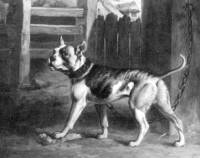 Bulldog 1804
Bulldog 1804
The British Bulldog was that small type of Mastiff developed for use in the sport of bull baiting which was born in England in 1209 AD. The story goes that when Lord Warren, then the Lord of Stamford witnessed a pack of dogs tormenting a bull, he was impressed by their athleticism and courage. So the next year, he leased part of his land for local butchers to supply a bull to be baited by trained dogs. When this became an annual event, the sport of bull baiting was born! It received Royal patronage and for several centuries combats between bulls and dogs became popular as entertainment. It was even believed that the flesh of a bull that had exerted itself by being baited before it was slaughtered by the butcher, was more succulent[1]. This practice became so universally accepted at this time that in various boroughs butchers, who sold beef from animals that had not been baited before slaughter, were subject to considerable penalties[2] !
 Baiting a Bull c 1746
Baiting a Bull c 1746
To bait a bull, the dog was expected to pin the bull to the ground by its nose and not lose its grip until the bull was slaughtered. As the dog had to crawl along the ground on its belly in order to get a grip on the bull's nose, a small lower-slung type of dog became popular[1]. By 1570, Dr.Caius had classified the small Mastiff that did this job efficiently as the Butcher's Dog.[6]
The British Bulldog becomes a Pure Breed
 Bulldogs 1876
Bulldogs 1876
The historical purpose of bull baiting was outlawed in 1835. By 1875 his regular appearance at dog shows had captured the interest of the press. The 'New Bulldog Club' was formed as a means of encouraging all breeders to take part in drawing up a scale of points on which a Breed Standard could be based. So the exaggerated features that make up the modern British Bulldog's unique thuggish appearance became a symbol of British grit.
 Bulldog 1885
Bulldog 1885
For this reason, the British Bulldog is considered to be Britain's National Dog
"... for no variety of canine species is so universally identified, both at home and abroad, with Great Britain as the subject of this present article. Bulldog pluck and endurance are qualifications eagerly cherished by Englishmen of all classes; and it would be manifestly unjust to deprive this dog (breed) of the title which has been so universally awarded him"[3].
 Bulldog 1906
Bulldog 1906
It would be equally unjust to fail to recognise his outstanding qualities as a loving companion as well as the unique physical features that have been preserved for almost 200 years by the Breed Standard and the advent of dog shows.
History of Bulldogs in Australia
 Wes Stacey with Bulldog
Wes Stacey with Bulldog
In Australia, 17 British Bulldogs were listed in the catalogue of the First Exhibition of Sporting and Other Dogs held at the Melbourne Exhibition Buildings in April 1864[4]. Another 3 were listed as having been imported before 1890 with an additional 45 by 1912. The Victorian Bulldog Club was founded in 1907 and was affiliated with the Victorian Poultry and Kennel Club holding an Annual Show and Parade. By 1912 some 159 Bulldogs were listed in Tyzack's Annual[5] demonstrating the immense popularity of Bulldogs in Australia from the earliest times of dog showing. Of particular note is Mr Wes Stacey who piloted Bulldogs in Australia for over 60 years. We feel privileged to have enjoyed his personal input into this page.
The British Bulldog Today
 Bulldog c 1928
Bulldog c 1928
Like any other pure breed, the modern Bulldog's physical characteristics make him instantly recognizable. But although the purpose for which he was bred has been outlawed since 1835, a century later his physical characteristics were recognized by the icon of his time, Ch Pugalist (pictured). It is important that modern society understands the historical use of for each and every feature preserved by enthusiasts that make up our modern Bulldog. So these features, together with their historical purpose, are tabulated below.
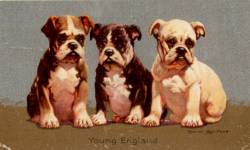 Bulldog Pups c 1930
Bulldog Pups c 1930
The British Bulldog is a smooth coated, thickset dog rather low in stature, but broad, powerful and compact. He should convey an impression of determination, strength and activity. He comes in any whole colour or smut (a whole colour with a black mask) or pied that is any whole colour with white. However dudley (pink), black or black and tan are undesirable. Although no actual height is given, his height should be consistent with a desirable weight of 25 kg (55 pounds) for a dog and 22.7 kg (50 pounds) for a bitch.
In the chart of the Bulldog below, each part of the dog's historical purpose is explained.
| Breed Standard | Historical Purpose | |
| Skull | Large, broad and square and flat. From the front it should appear high with cheeks well rounded and extending sideways beyond the outline of the eyes | This huge head and cheek muscles gave room for the attachment of the large muscles of the jaws |
| Stop | The furrow forming the stop should be deep and wide, extending from the middle of the skull to a position in front of the eyes | This formed a channel so the blood from the bull could run down between dog's eyes so the dog was not blinded by bull's blood |
| Muzzle | Short, broad, very deep from corner of eye to corner of mouth with the lower jaw projecting considerably in front of the upper jaw and turning upwards | The width of the jaw gave the dog its strength while the upward turn allowed the dog to grasp the bull more easily by the nose |
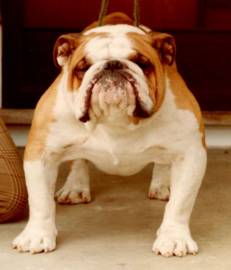 Bulldog Bulldog |
 Bulldog Bulldog |
|
| Nose | Large, broad and black with wide open nostrils with the top deeply set back almost between the eyes | This upturned large nose with open nostrils was tilted back on an angle so the dog could breathe properly when holding the bull by its nose |
| Wrinkle | The skin on the foreface should be deep and closely wrinkled | The wrinkle over the foreface diverted the bull's blood away from the dog's eyes and nose, encouraging it to run down the muzzle |
| Flews (Chops) | Thick, broad and pendant completely covering the lower jaw | So the bull's blood could then run down the chops to the dewlap and did not run into the dog's mouth where it could congeal |
| Neck | Very thick deep and strong with much loose, thick and wrinkled skin about the throat forming a dewlap on each side running from lower jaw to the chest | The neck must sufficiently strong to support not only the large head but also the extraordinary musculation of the shoulders. The wrinkled skin which forms the dewlap protected the throat |
| Eyes | Round, very dark and situated low down in the skull, wide apart and facing forwards | The width between the eyes allowed the dog some peripheral vision |
| Ears | Rose-shaped, set high on the head extending the outline of the skull, small in size, thin in texture | The size, thin texture and rose shape of the ears are important factors that minimise injury when the dog was baiting the bull |
| Mouth | Undershot square jaw, broad with 6 incisors between the canine teeth. Teeth large and strong. Never wry | Although undershot, it is most important that the Bulldog's teeth are strong and the jaws parallel to each other and not offset |
 Bulldog Bulldog |
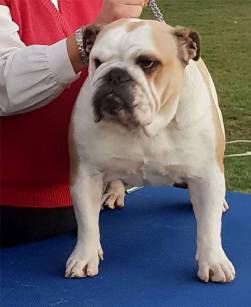 Bulldog Bulldog |
|
| Shoulders | The shoulders must be so broad, powerful and muscular they give the appearance of being tacked on to the body | This extraordinary muscular shoulder development gave the Bulldog strength to hold the bull. |
| Forelegs | The strong, straight bones of the forelegs should appear shorter than the hind legs and set wide apart. The well developed muscles of the forearms may give them a bandy appearance. | The bone appears large and round, and their width apart assisted him with balance. But the forelegs although shorter than the hind, must appear in proportion with the dog as a whole. |
| Pasterns | Short straight and strong | For strength |
| Feet | Round and compact with the forefeet allowed to turn slightly outwards | The slightly outwards turn of the forefeet also assisted him with balance |
| Body | The pear-shaped body is short with broad and laterally round ribcage from the top of the shoulders to the brisket. Viewed from the front, this depth makes the dog appear short-legged | Although the shoulders are the widest part of the dog, the deep ribcage actually hangs between the widely placed forelegs providing plenty of room to house the heart and lungs |
| Topline | The shoulders appear lower than the loins. This is because of the slight dip behind the shoulders, then the greater rise over the loins to a sudden drop to the low-set tail. | This roach back is caused by immense musculation of the loins, typical of any dog with an athletic build |
 Bulldog Bulldog |
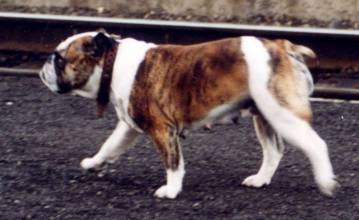 Bulldog Bulldog |
|
| Underline | Although this dog has a short strong back, he has a long ribcage combined with the tucked up belly | This tight belly with no loose skin protected his vulnerable parts |
| Hindquarters | The large muscular hindlegs should be longer than the forelegs, so elevating the loins. The well turned stifles should turn outwards slightly, making the dog a little cow-hocked | Although strong and muscular, the hindquarters are much narrower than the shoulders. The slight cow-hocks enable the dog to bring his hind legs underneath his belly |
| Tail (Stern) | The low-set tail is short, thick at the root where it first juts out from the body and tapers to a point as it turns downwards. It should be straight and devoid of any fringes of coarse hair. | The Bulldog's naturally short tail should always be straight and not have any kinks or curves at the end. |
| Gait | He moves with a heavy and constrained gait, with short quick steps. His hind feet are not lifted high, but appear to just skim the ground. It is typical to move with his right shoulder rather advanced, similar to a horse cantering. | His pear shaped body gives him this peculiar rolling gait, appearing to walk on the tips of his toes, with his right shoulder rather advanced. As this could make him appear to be crabbing or even lame, it is important to understand the difference! |
References and Further Reading
[1] John F Gordon F.Z.S, 'The Bulldog Handbook' Published by Nicholson & Watson, London 1957 Chapter 1 Pages 9 - 12.
[2] Robert Leighton "The Book of the Dog" published circa 1905 Subscriber's Edition, The Waverley Book Co. Ltd. Volume 1 Chapter 11 'The Bulldog' by W.J. Stubbs Page 36
[3] Vero Shaw B.A. "The Illustrated Book of the Dog" published Cassell, Petter, Galpin & Co. London, Paris & New York Chapter X Page 83
[4] Catalogue of the First Exhibition of Sporting & Other Dogs, Thursday & Friday April 7 & 8, 1864 promoted by the Council of the Acclimatisation Society, printed in Melbourne by Mason & Firth, Printers, Flinders Lane West Page 12 - 13
[5] "Tyzack's Annual" Compiled by T. W.Tyzack and C.S.Turner Published by the Victorian Poultry and Kennel Club Printed in 1912 by Bellamine Bros. Printers, 66-70 Flinders Lane Melbourne Pages 7 - 17 and 83 - 84
[6] Dr John Caius, "Of Englishe Dogges: The Diuersities, the Names, the Natures, and the Properties", London, 1576, translated into English by Abraham Fleming, Page 31. The work was originally published in Latin in 1570 as "Johannes Caius, De Canibus Britannicis".
[7] J.H.Walsh, under the name 'Stonehenge', 'The Dogs of the British Islands' (Fifth Edition) Published by 'The Field' Office, 346 Strand, W.C.London 1886. Part lll Non-Sporting Dogs Book l, 'Watch Dogs', Chapter l, The Bulldog and the Mastiff'. The Bulldog Facing Page 177